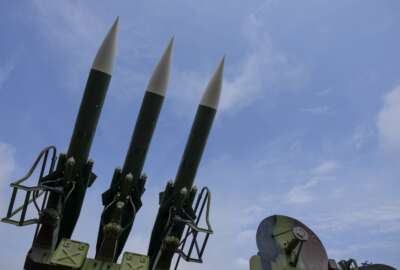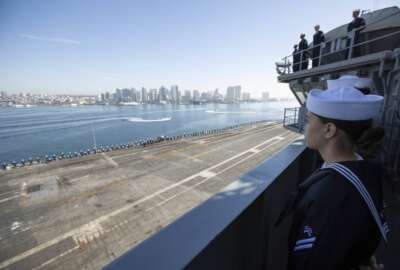Navy to turn training exercises into testing ground for new technologies
As part of the standup of four new Navy warfighting development centers, the Office of Naval Research seeks to insert the testing and prototyping of new...
The Navy is setting up what it hopes will be repeatable, regular processes for testing new technologies that seem like good candidates for fielding throughout the fleet. The objective is to get new equipment into sailors’ hands as quickly as possible by turning the Navy’s existing training exercises into proving grounds for new systems.
The updated approach to testing and prototyping is part of a reorganization of the Navy’s capability development infrastructure that Adm. Jonathan Greenert, the outgoing chief of naval operations, ordered at the end of June. Four new warfighting development centers will report directly to the operational type commanders for their given specialties: undersea warfare, aviation, surface warfare and expeditionary warfare.
Rear Adm. Mat Winter, the chief of naval research, said his office is populating those new centers with “all-domain” science advisers. Their job will be to connect the Navy’s planners for demonstrations and exercises with scientists at the Office of Naval Research so that when a new technology is identified in the Navy’s research community, there’s a venue to conduct testing or prototyping in real-world conditions.
“There are going to be demonstrations and experiments of immature technologies as well as application of more-mature prototype technologies,” he said. “We’re working with each of those warfighting development centers and Fleet Forces Command to ensure they are aware of the technology we’re working on and we can get them on the docket during fleet exercises in a repeatable, institutionalized way.”
It’s a different process from the one the Navy has used to test new technologies in the past, he told a future naval capabilities forum hosted by the Center for Strategic and International Studies.
“It hasn’t exactly been ad-hoc, but predominantly, it’s only been done where certain individuals within the Navy happen to know each other. It’s a new organizational methodology to get our programs into those exercises and it’s part of the chief of naval operations’ push to get things ‘wet’ sooner,” Winter said.
Vice Adm. Joseph Aucoin, the deputy chief of naval operations for warfare systems, said the creation of the new centers are just one of a few recent changes the Navy’s made to improve its ability to onboard new technologies and ensure the service’s operational communities can make efficient use of the work conducted by its technologists and in industry.
In April, for example, the Navy created a deputy assistant secretary for unmanned systems. And a parallel office (N99) within the Navy Staff will serve as the single resource sponsor for all of the service’s research and operations for future drone technology, whether in the air or beneath the sea. The office will be up and running in September, Aucoin said.
“It’s going to take all of the stakeholders and operators in the unmanned world and put them under one hat,” he said. “We looked at all the things going on in the unmanned world and there are more than 300 Navy projects taking place. We need to combine all of that so that we’re not, for example, building ground stations that are all unique. But that’s only the start. We need to use emerging technology better across-the-board. I want N99 to harness emerging technology, get it out into the fleet and be willing to fail.”
Among the Navy’s top research priorities, Winter listed directed energy, electric weaponry and undersea dominance.
In the latter category, he said current research has barely scratched the surface of what could eventually lead to a subterranean resupply and logistics network over thousands of miles of sea bed, so interconnected that it resembles a global undersea version of the U.S. interstate system.
The Office of Naval Research also is interested in the electromagnetic spectrum — both in terms of offensive electronic warfare capabilities and in devising new ways to make use of the wireless spectrum. Winter declined to describe the Navy’s spectrum research in much detail since most of its programs in that area are classified.
But Aucoin said the Navy needs to seriously examine its approach to the electromagnetic spectrum from a defensive perspective as well. The Navy, he said, so far has taken for granted that it will have plenty of bandwidth at all times and that enemies won’t be able to interfere with its communications.
“We have to have better discipline,” he said. “Over the last 15 years, we’ve grown very comfortable, because we’ve been fighting two wars over land and we had as much bandwidth as we needed. Before that, during the Cold War, we did practice a lot of discipline about how we used communications. That’s gone out of favor and we need to re-instill that. Right now, we’re pretty overweight in terms of our dependence on network services. We can really come down on our consumption: you may not get streaming video or video teleconferences. We need to be able work in a communications-denied environment. The one thing we are concerned about is precision navigation and timing. If we lose that, things can really go awry with command and control and our weapons systems. That is a primary concern of ours.”
Copyright © 2025 Federal News Network. All rights reserved. This website is not intended for users located within the European Economic Area.
Jared Serbu is deputy editor of Federal News Network and reports on the Defense Department’s contracting, legislative, workforce and IT issues.
Follow @jserbuWFED






